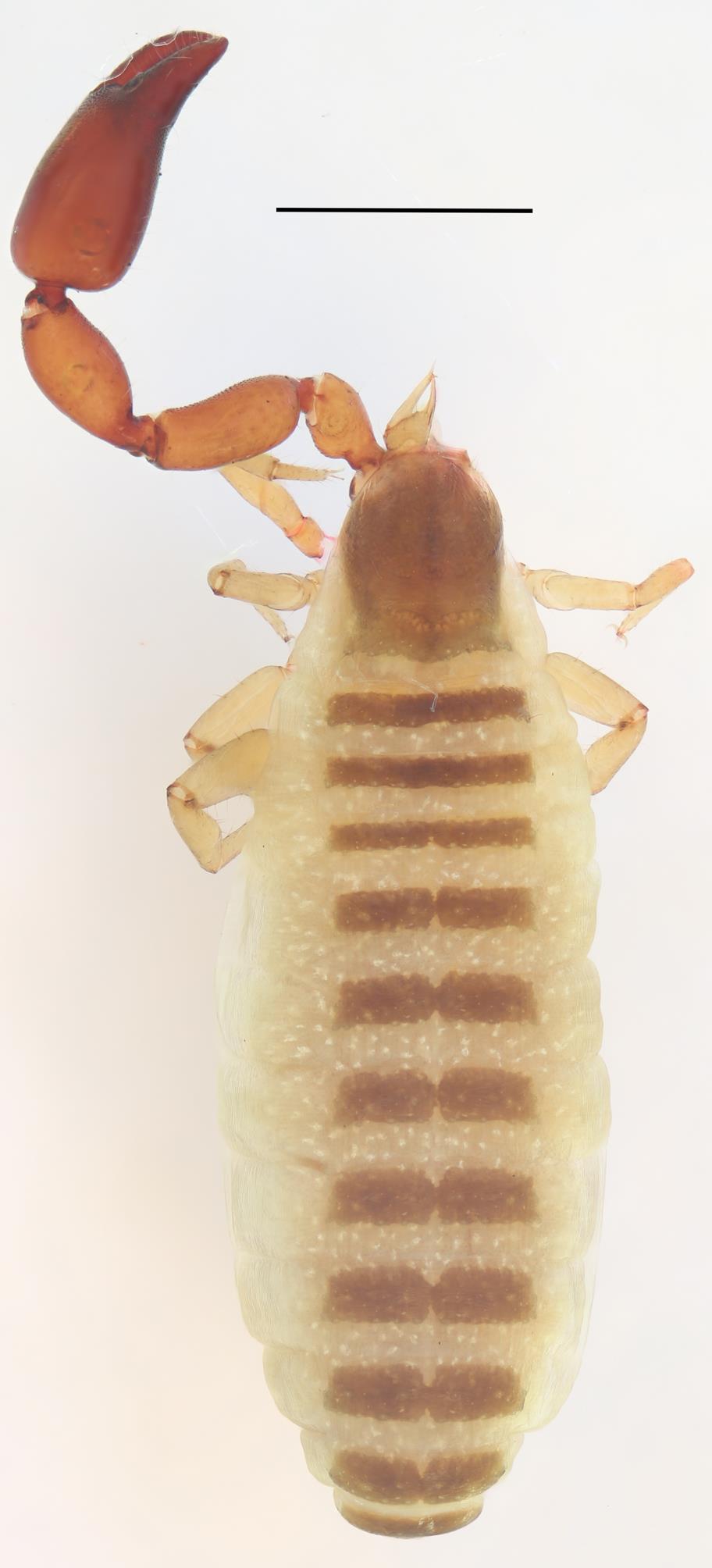Description of a new cave-dwelling pseudoscorpion, Anatemnus hemuensis sp. nov. (Pseudoscorpiones, Atemnidae) from Gaoligong Mountain, China
doi: 10.11932/karst20210617
-
摘要:
本研究根据从云南省高黎贡山(保山市段)洞穴采集的伪蝎标本,整理并描述了阿伪蝎科安伪蝎属一新种,即禾木安伪蝎(Anatemnus hemuensis sp. nov.)。该属的主要特征在于触肢粗壮,腿节和膝节多具明显颗粒,不动指上的听毛it位于指的中部,听毛esb到est之间的距离大于isb到ist之间的距离,背板不完全分隔。世界已知22种(不包含本文新种),主要分布于非洲和美洲,中国仅知3种:任氏安伪蝎(A. reni Gao & Zhang, 2016)、宝安伪蝎(A. orites (Thorell, 1889))、潮州安伪蝎(A. chaozhouensis Hu & Zhang, 2012)。该新种背甲的眼部已经完全退化,依据该特征,很容易区分,除分布于澳大利亚的2个物种(A. subvastus Alexander, Burger & Harvey 2014,采集自地下环境;A. cavernicola Berier, 1976,采集自Jump Up Cave),然后依据步足I和步足IV跗节端部具有极其弯曲的刚毛将新种与这两种进行区分。新种触肢转节具有1个明显的背突,1.7倍长于宽(0.47/0.28 mm),腿节2.8倍长于宽(0.90/0.32 mm),膝节2.2倍长于宽(0.82/0.37 mm),螯肢指明显短于具柄的螯掌;前螯螯掌具有4根刚毛,基部2根末端齿状,盔状物具有5个分叉,鞭状毛4根,末端2根齿状;口下突有5根顶端毛和1根亚中毛。在文中提供了新种的整体图以及特征图,另外还提供了中国安伪蝎属的分种检索表,所检视的标本保存于西华师范大学生命科学学院昆虫标本馆。
Abstract:Currently,the research of cave-dwelling pseudoscorpion in Gaoligong Mountain lags behind. This paper aims to clarify its species diversity by collecting the specimens of cave-dwelling pseudoscorpion in this area. The collected specimens were identified by traditional classical characteristics. After systematic investigation and sorting out seven cave specimens belonging to Gaoligong Mountain, two kinds of pseudoscorpion were found. After reviewing relevant references, a new species Anatemnus hemuensis sp. nov. was found. Then the description and drawing of this new species were made in this paper. -
Key words:
- pseudoscorpion /
- taxonomy /
- identification key /
- Yunnan
-
Figure Fig.2. Anatemnus hemuensis sp. nov., female (holotype) (A.carapace B.right chelicera C.rallum of right chelicera D.right leg I, lateral view E.right leg IV, lateral view F.genital area G.chela, retrolateral view H.chela, dorsal view I.palp (minus chela), dorsal view (Scale bars, 0.5 mm (A-B, D-I), 0.1 mm (C))
表 Table 1 Key to the species of Anatemnus known from China
species Pedipalpal trochanter Carapace collecting environment Chela with pedicel length/breadth A. reni Gao & Zhang, 2016 two well-developed conical tubercles with eyespots under bark 3.35 times longer than broad A. hemuensis sp. nov. one well-developed conical tubercle without eyes or eyespots under stones (cave) 1.41 times longer than broad A. chaozhouensis Hu & Zhang, 2012 one well-developed conical tubercle with eyespots under bark 2.89 to 3.09 times longer than broad A. orites (Thorell, 1889) one well-developed conical tubercle with eyespots under bark 2.20 times longer than broad -
HuJ F, ZhangF. A new species of the genus Anatemnus (Pseudoscorpiones, Atemnidae) from China[J]. ISRN Zoology, 2012, 164753. HarveyM S. Pseudoscorpions of the World, version 3.0 [DB/OL]. Western Australian Museum, Perth, 2013, Available at http://www.museum.wa.gov.au/catalogues-beta/pseudoscorpions/ (accessed 28 September 2021). AlexanderJ B, BurgerM A A, HarveyM S. A new species of troglobitic Anatemnus (Pseudoscorpiones: Atemnidae) from the Pilbara bioregion of Australia[J]. Records of The Western Australian Museum, 2014, 29: 141-148. GaoZ Z, ZhangF. Description of a new species of the genus Anatemnus Beier, 1932 (Pseudoscorpiones: Atemnidae) from China[J]. Ecologica Montenegrina, 2016, 7: 567-572. BeierM. Revision der Atemnidae (Pseudoscorpionidea)[J]. Zoologische Jahrbücher, Abteilung für Systematik, Ökologie und Geographie der Tiere, 1932, 62: 547-610. ChamberlinJ C. The arachnid order Chelonethida[J]. Stanford University Publications, University Series (Biol. Sci.), 1931, 7: 1-284. HarveyM S. The phylogeny and classification of the Pseudoscorpionida (Chelicerata: Arachnida)[J]. Invertebrate Taxonomy, 1992, 6: 1373-1435. JudsonM L I. A new and endangered species of the pseudoscorpion genus Lagynochthonius from a cave in Vietnam, with notes on chelal morphology and the composition of the Tyrannochthoniini (Arachnida, Chelonethi, Chthoniidae)[J]. Zootaxa, 2007, 1627: 53-68. BeierM. A cavernicolous Atemnid pseudoscorpion from new south wales[J]. Australian Journal of Entomology, 1976, 15(3): 271-272. -





 下载:
下载:



